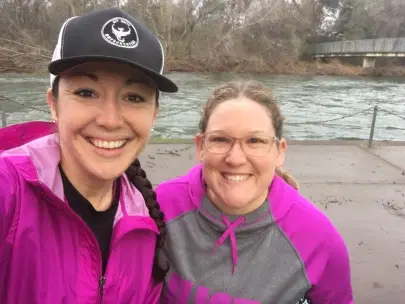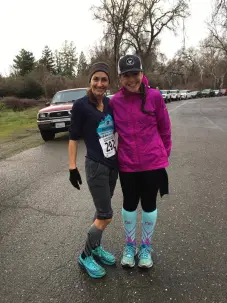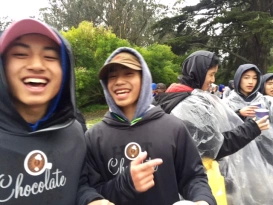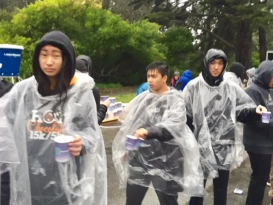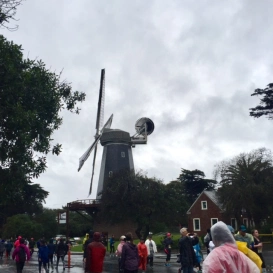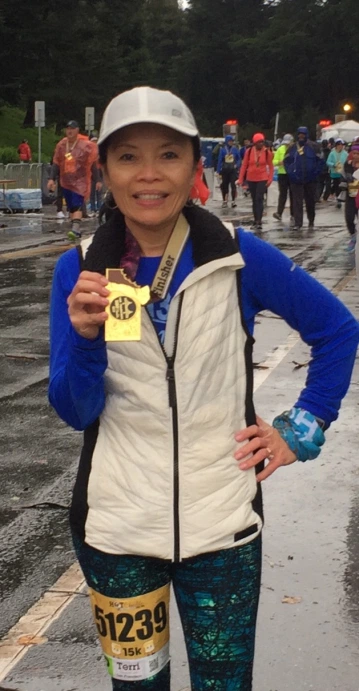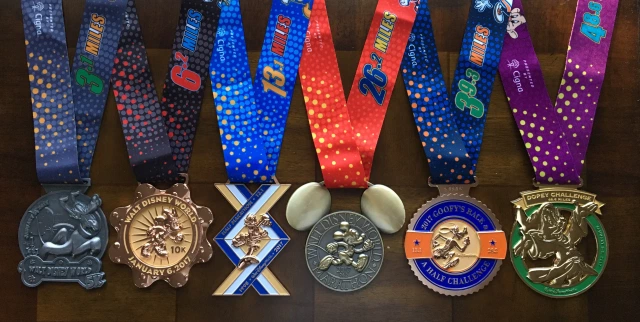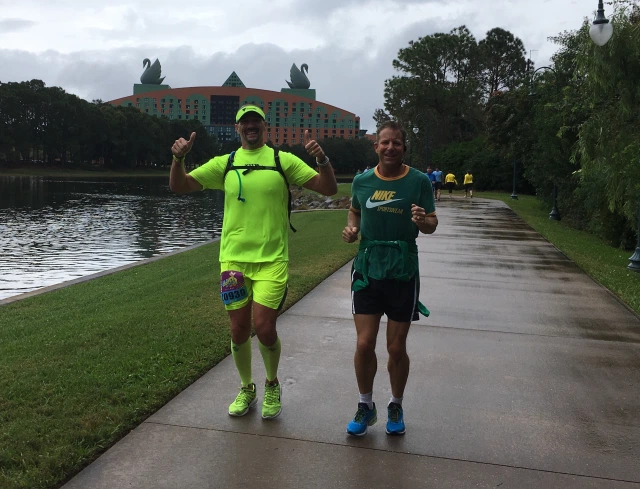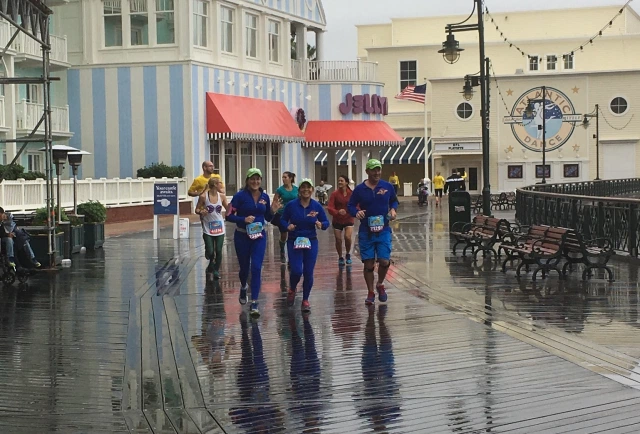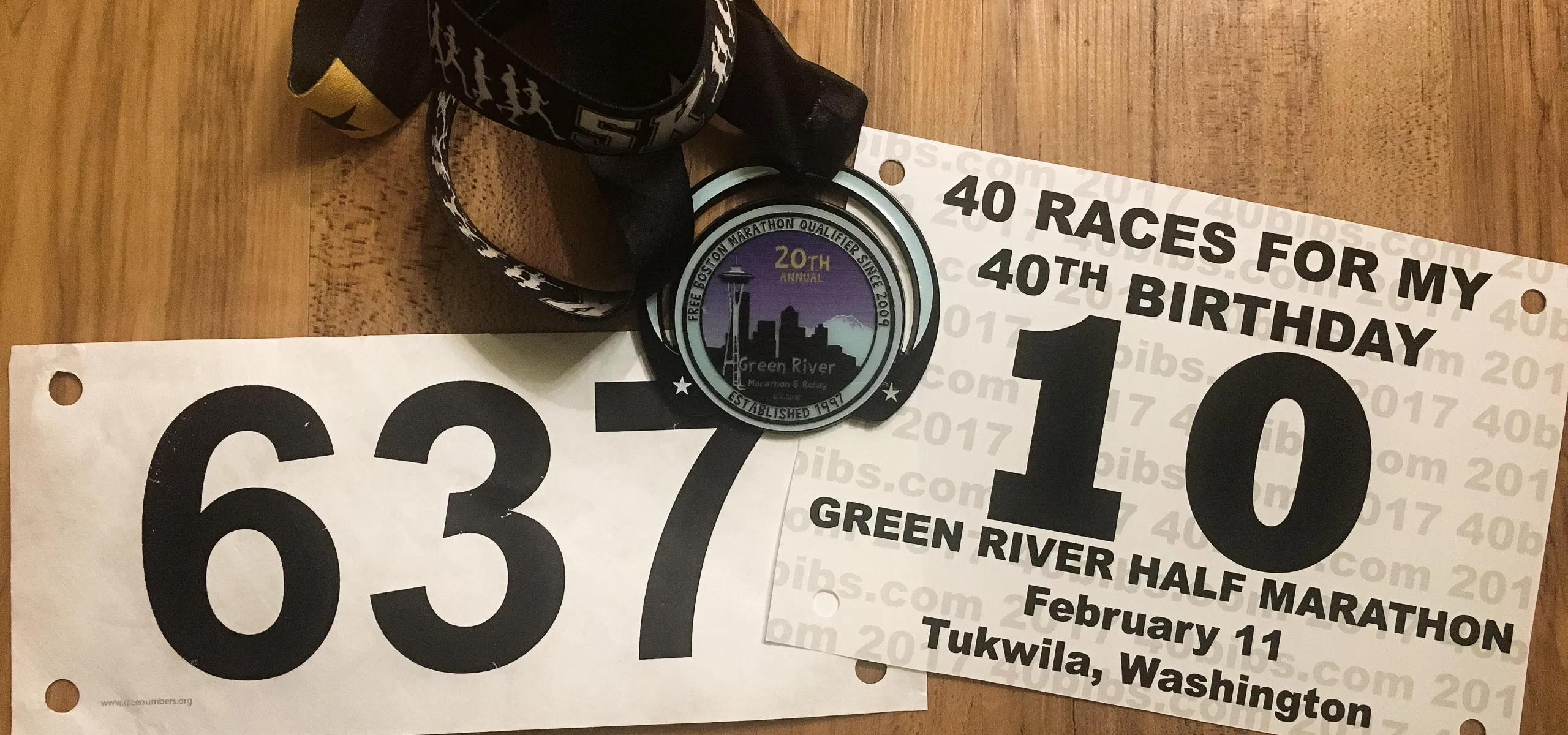
When you run enough races, you learn to anticipate the crowd and the atmosphere based on the web sign-up alone. Rotating photo-banners with multiple tabs and pages tend to be large races, with high-quality t-shirts and well-crafted medals where you can expect a post-race smorgasbord and, if you’re really lucky, beer. Less sophisticated sites usually mean less aid, but a often a friendlier, more low key crowd in attendance; people indifferent to the trappings of “big race” flash. The website for the Green River Half Marathon is sparse, to say the least. Some of the links didn’t work. Registering involved sending an email to the Race Director with my name, address and date of birth, and bringing a $20 suggested donation for Northwest Harvest, a local food bank. This wasn’t a race; it was a group run. (Check out my live start line video here!)
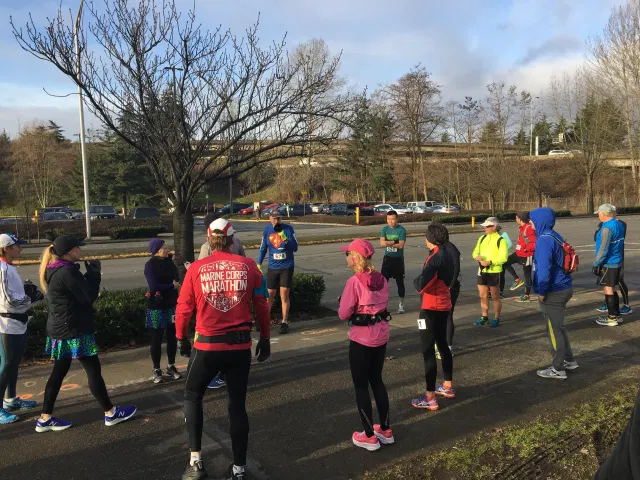
The Race Director provides final instructions at the “start line.”
In races like this, it’s not uncommon for participants to run in groups of two, three or more, happily acknowledging others they are passing, or who are passing them. If a high school hallway was a blissful, judgment-free utopia, it would be a run like this.
I came up on Tyler around Mile 3. A fellow member of the online running group, Run The Year, he recognized me from posts on the site. Strangers less than an hour before, Tyler and I spent the next 10 miles together, regaling one another with race stories. On April 30, Tyler will run his 100th half marathon in just five years, reminding me there are amazing people achieving amazing goals everywhere.
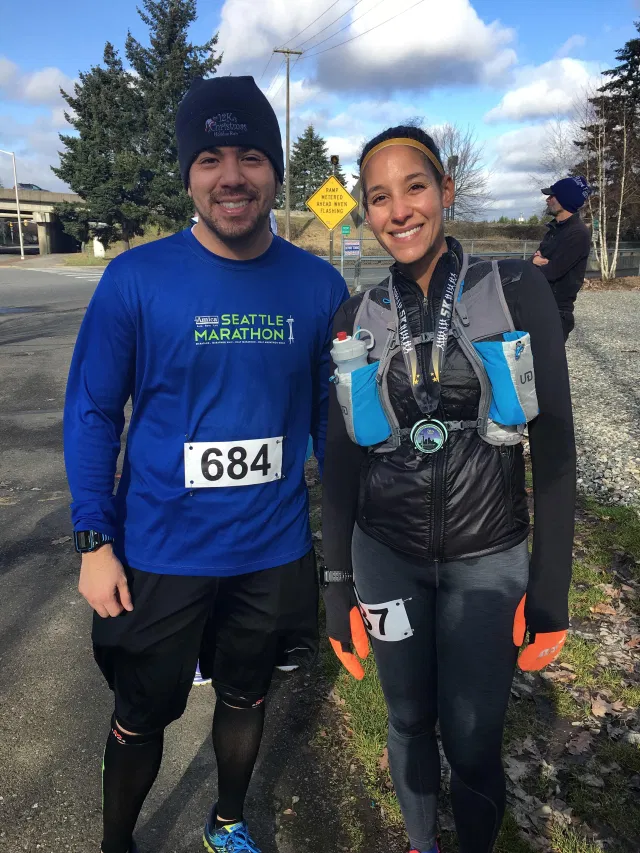
Me and Tyler, post-race.
There were no mylar wraps or tables of bagels and bananas at the finish; just a handful of dedicated volunteers, a jug of Gatorade, and someone blowing a train whistle. And plastic medals, leftover from the Race Director’s signature marathon last June for those who wanted one. “Sure!” I said, happily bending over so the volunteer could place the medal over my head. I don’t need any more medals, but I got a kick out of receiving a 2016 marathon medal for finishing a 2017 half marathon. In fact, the race ribbon says “5k” on it.
There are people for whom this kind of race is not worth getting out of bed. I am not one of those people.

“Is there a race up there?” I asked the woman running down the steep, grassy patch cutting the corner on the intersection between Lake Washington Boulevard and Interlaken Boulevard. “Um, yes,” she responded. “You go up and across 24th. You have to cross back over 24th.”
I said, “thank you,” but what I meant was a four letter word, starting with F. I looked at my watch. This race was starting in five minutes, and I couldn’t find the start line.
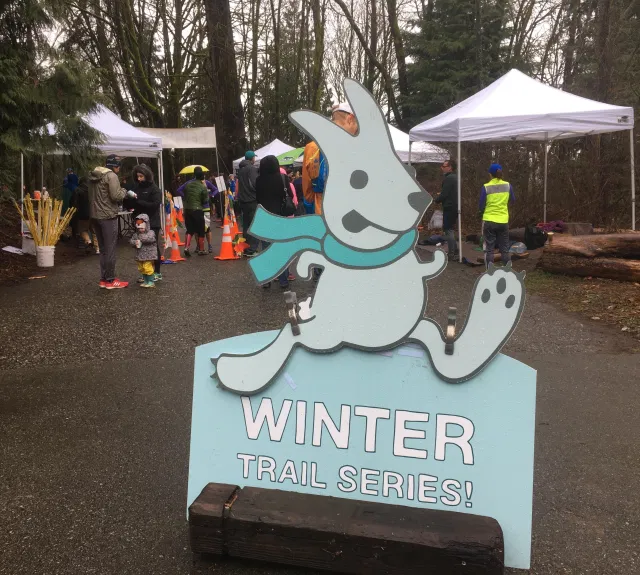
The elusive start line. The Interlaken Icicle Dash is the last race in the Northwest Trail Runs Winter Trail Series. Nevertheless, Seattle saw four inches of snow the following morning, knocking out power to 90,000 around Puget Sound. It turns out the rabbit is no smarter than the groundhog.
Just 2.5 miles from my house, the Interlaken Icicle Dash 10k offered a chance to run close to home, on a course with which I was familiar. The road portion of this course is on one of my regular long running routes. It has undulating hills, under a canopy of moss-covered trees. It feels damp and lush all year round. But when I left my house, intending a slow, 2.5 mile jog to the start, I’ll admit I wasn’t exactly sure where the start line was. When I hit 2 miles I thought I’d begin to see parked cars. At 2.5 miles I made the poor decision to keep running straight when I didn’t the race to my right, as I thought I would. At 3 miles, I ran into the woman who pointed me in the right direction — .25 miles up a hill with 6% grade and across a busy street — another .5 miles away and back towards the way I’d just come. F.
The race clock clicked to 2:02 when I finally crossed the start line. I’d arrived at the bib tent with seconds to spare, but by then I had to go to the bathroom so badly it didn’t matter. Unlike larger road races, smaller runs are not chip-timed. Everybody’s clock starts in time with the official race clock. My finish time would reflect this additional 2:02 during which I’d been relieving myself in the porta-potty.
The race, a 5k and 10k, featured multiple, 1.5 mile loops through Interlaken Park in Seattle’s Capitol Hill neighborhood. While the paved portions are wide enough for cars to pass in either direction, the trail portions are narrow, and include stretches of what is known as “single track,” narrow footpaths un-runnable on either side. This means if you get caught behind someone slower than you, it is impossible to go around them. You need to wait until a widening in the trail, or at least a safe spot where they can step off to the side for you to continue through. Golfers yell Fore! when they’ve hit a ball into another path. Trail runners give a friendly yet stern, On your left! In other words, starting a trail race two minutes behind the entire field is not a test of endurance to catch up; it’s a test of patience to go slow.
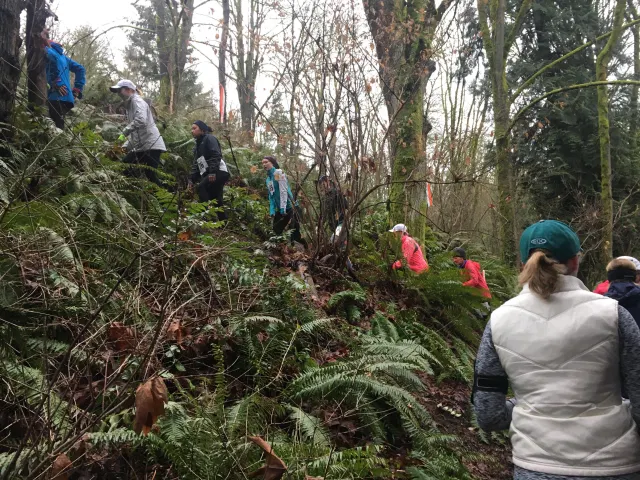
The first major climb on the course, 1.5 miles in. Still well behind runners at my preferred pace, I’m forced to stand in a long line of runners waiting to ascend. I snapped a few photos to pass the time.

The official race photographer catches me skipping the stairs in favor of the downhill slope where I can run faster, passing more people. As I assured my husband, “legal” in a trial race.
I was 2.5 miles into my race when I finally reached those at my pace, and continued the race unencumbered.
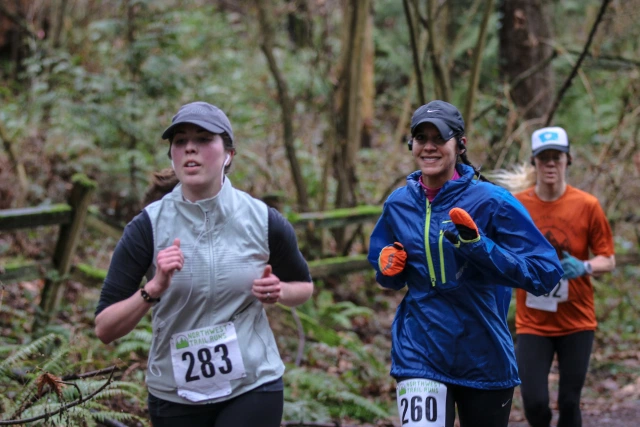
Inside the last mile, and running with “my people.”
Given the slow start, and the +2:02 I mentally removed from my official time (oh, and that I ran a half marathon yesterday), I thought my finish wasn’t all that bad. In fact, the official results would show that I finished 20th out of 40 women in the 10k. And had I completed 2:02 faster, I would have been … 20th. (Check out my live finish line report here!)
I made the short, happy jog back to my house.
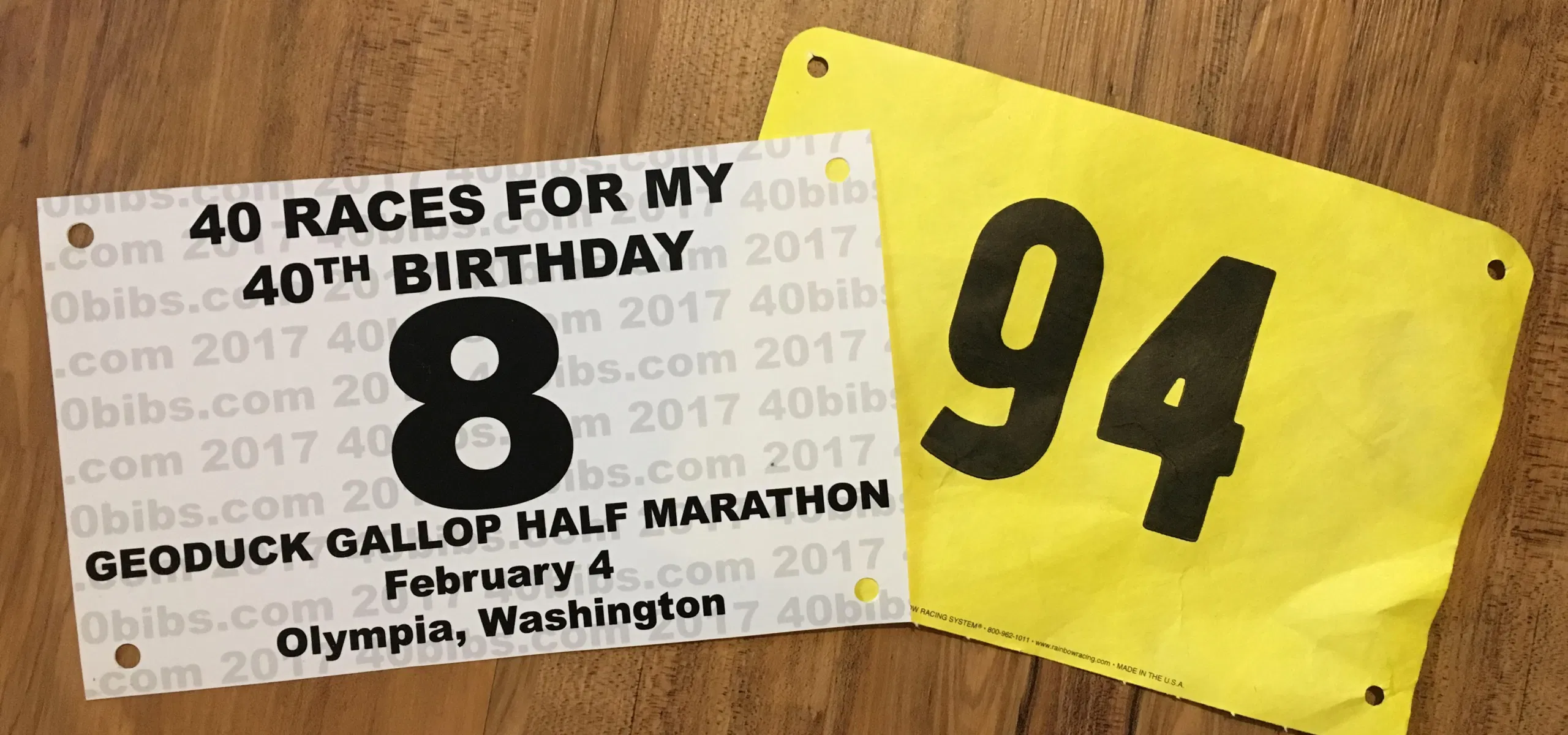
The Flying Pig. The Heartbreaker Half. The Wattle Waddle. Grandma’s. The Zoom Ya Ya. The Quad Dipsea… Sure, plenty of runners race the “New York City Marathon,” but even more run races with names that have no discernible connection to, well, English sometimes.
The Geoduck Gallop. Pronounced “Gooey Duck,” for the uninitiated. 13.1 miles around the Evergreen State College campus in Olympia, Washington. And home of Speedy, the Geoduck. (Check out my live start line report here!)

Me and Speedy the Geoduck, post-race.
Despite this mascot caricature, geoducks look less like adorable snails, and more like radioactive phallic clams. Or something. The Geoduck is the world’s largest burrowing clam (fun fact), and is named after the native Lushootseed tribe’s word for “dig deep,” a feature that made it attractive to administrators when searching for a mascot, according to the Evergreen State website.
It is a symbol of the essence of the college: accessible to all who are willing to dig deep. – Evergreen State College website
Kind of like a race bib.
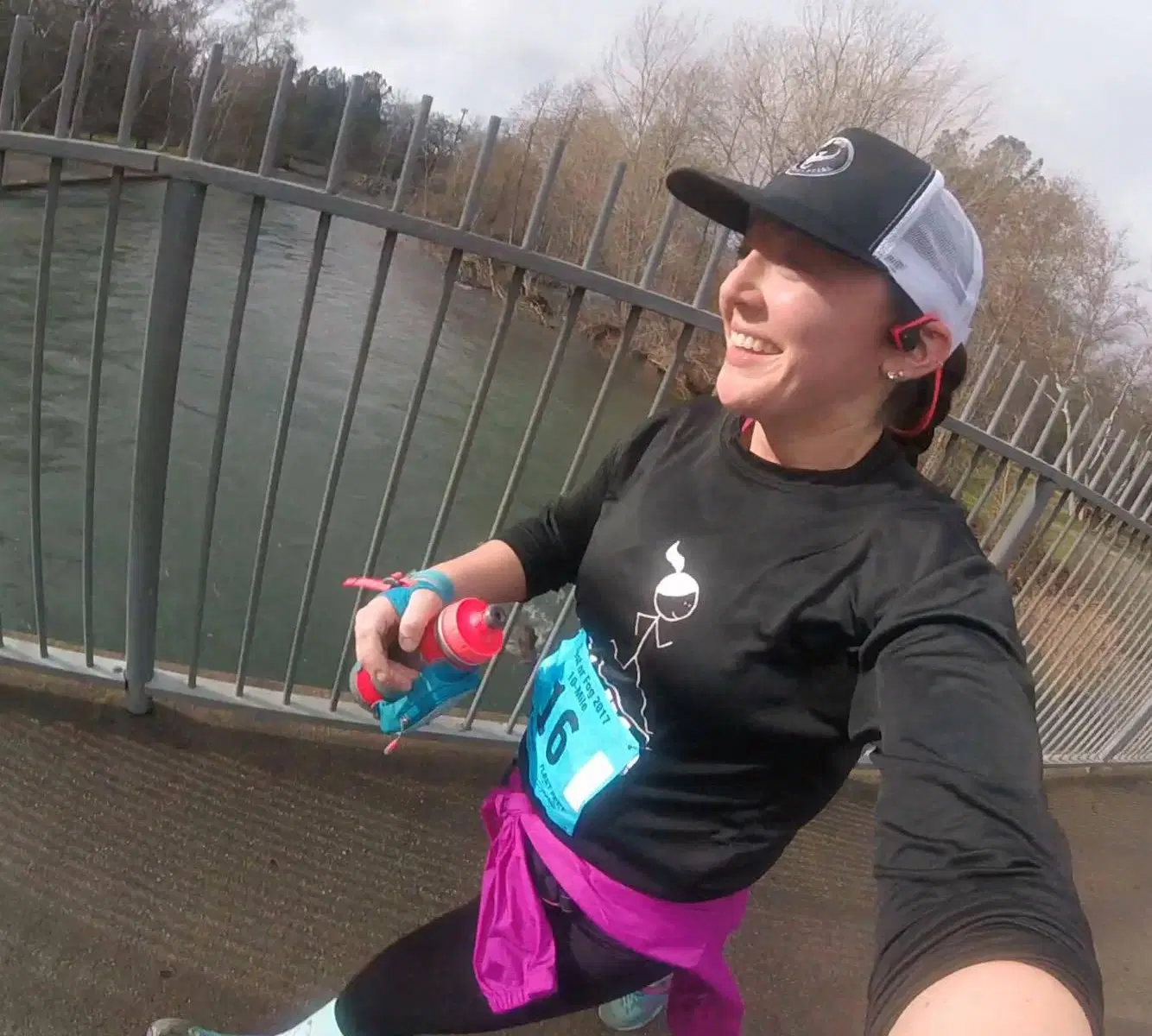
I am so excited to have the opportunity to share the experiences of others running “with me” virtually on my quest to complete 40 races in 2017 for my 40th birthday. One of those amazing runners is Stephanie who, over the weekend, completed the Frost or Fog 10 mile trail run in Chico, California. Make sure to check out Stephanie’s full race recap at her blog, Run Strong Run!

Stephanie, ready to go at what looks to be a less frosty and more foggy race start.
There are two kinds of distance runs out there – road and trail. And, no disrespect to the road runners (I am proud to be one), but trail running is where the wild things live! So to use a trail run in January to test year-over-year fitness gains says something about how strong and determined Stephanie is.
One of my favorite January races is the Frost or Fog trail run located in Upper Bidwell Park in Chico, California. It is a fantastic race to help show me my level of fitness at the start of a new calendar year. – Stephanie
Accompanied by her friends, Stephanie took on the hilly, wet course. Check out her YouTube video of the run!
As for the course, it was once again a challenging course for someone who doesn’t run trails very often nor does hill repeats very often. I looked up our elevation gain and it was only 585 feet. It definitely did not feel like only 585 feet! My heart rate topped out at 196 beats per minute! – Stephanie
While she didn’t set a personal record, Stephanie had a great race, as evidenced by the on-trail photos and post-race shenanigans!

Thank you to Stephanie for her fantastic race recap, and for running “with me” for my birthday!
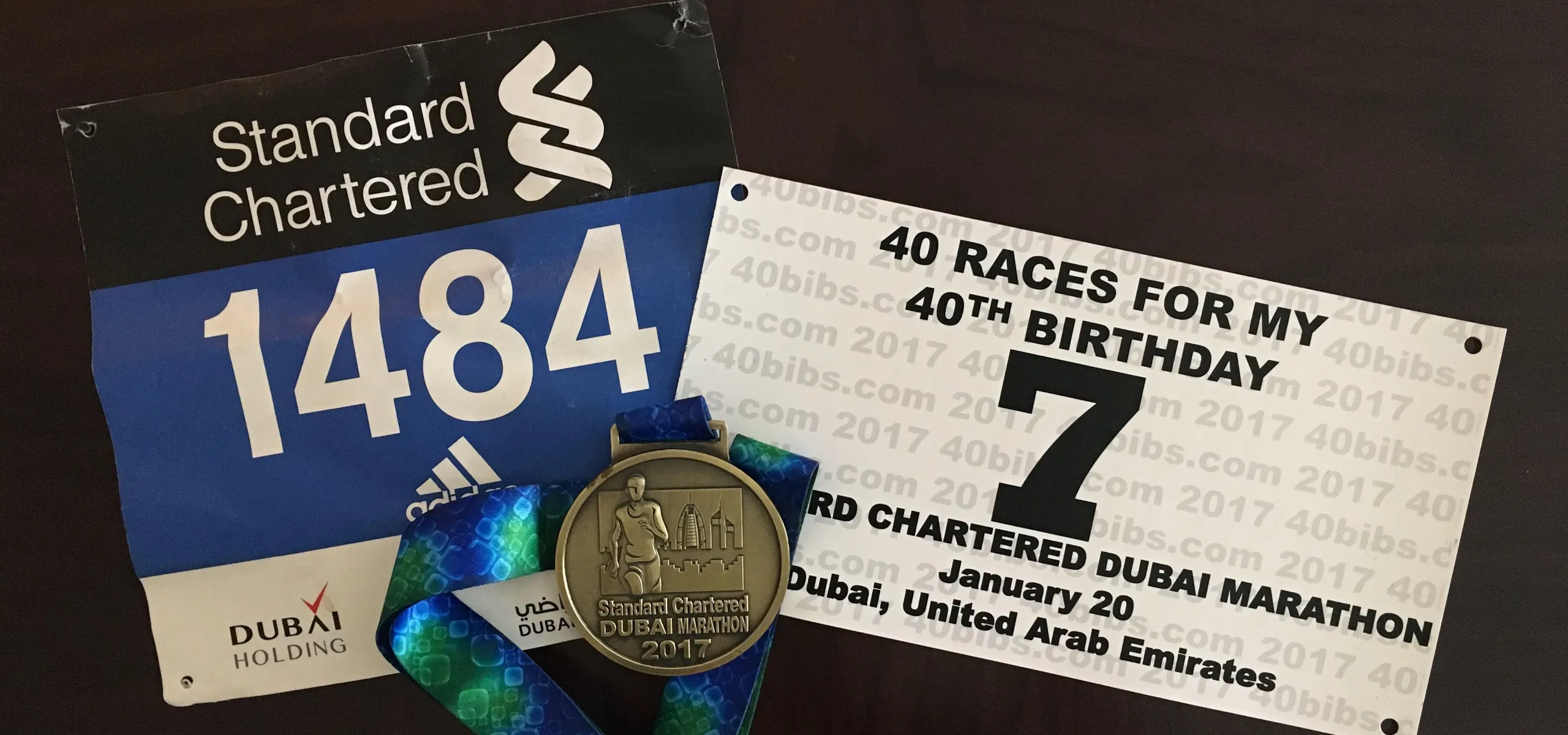
“Beat Bekele!” Sam, a member of my online running group, Run the Year, wrote me just before race start (check out my live start-line broadcast). Sam was referring to Kenenisa Bekele, the elite Ethopian runner who was making a very public attempt at the World Record – 2:02:57 – at the Standard Chartered Dubai Marathon. I laughed, knowing I wouldn’t yet be at the 21k split, the race’s half-way point, in 2:02. It never occurred to me that, when the race was over, I actually would have beaten Bekele.
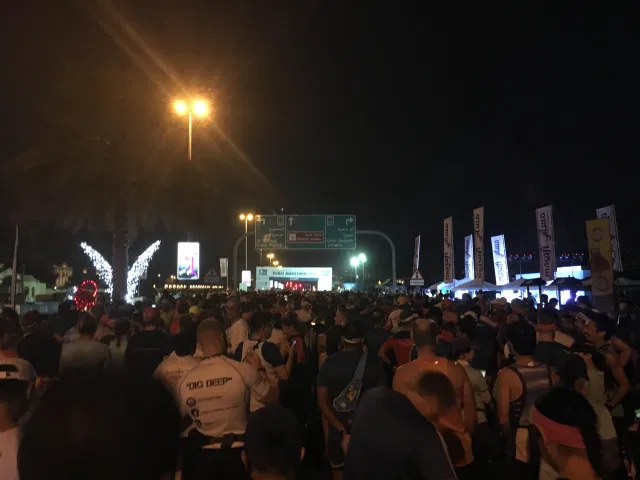
10,000 runners ready at the 6:30am start.
The Marathon course is an out and back. Runners exit the start and make a left onto Al Sufouh road and after approximately 5k, turn around and run back the way they came to 26k, and turn back around again. That means I would have two chances to see Bekele running at me as he made his epic run at history.
The lead men’s pack first passed when I was around 2.5 miles, already a full three miles ahead. Elite runners, effortlessly moving together at a sub-five minute pace, are breathtaking. And, while I couldn’t pick Bekele out of the pack, I looked forward to seeing him again in another 10 miles, where I hoped he would be leading.

The men’s elite field just beyond their five-mile mark. I have a clear photo, but this one more accurately expresses the feeling of watching them pass. Runners on my side of the street, three miles behind the elites, actually stopped our races, standing on the grassy median to watch what most of us hoped would be history in the making.
In fact, Bekele never led. When the race’s eventual winner, Tamirat Tola, came by me at my 10.65 mile mark with, as it turned out, just 19-minutes left to go, I didn’t know who he was. I just knew he wasn’t Bekele.
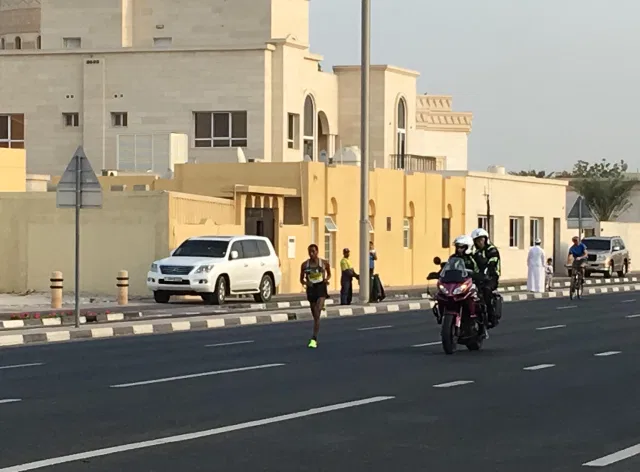
The lone lead runner, Tamirat Tola, with approximately 20 minutes left to go in his race. He would go on to set both a personal record and a course record at 2:04:11.
I wouldn’t learn until my race was over that Bekele actually dropped out around 21k. I watched the video of him falling at the start, where he’d gotten tangled up in the other runners, hurting his elbow and calf. In that fall is the intersection between elite, professional runners like Bekele and the rest of us. How many times do we make big race plans for ourselves, and at what point do we give them up?
My Dubai race plan was simple – have fun and don’t worry about the clock. After three consecutive days of racing in Walt Disney World, I’d almost hit a marathon PR myself on day number four, and that was just twelve days ago. Like Disney, Dubai was not an “A race” for me. Rather, it was a training run along the way to the Black Canyon 100k, just one month away. I expected to finish in 4:30-4:45, an “easy” pace with photo stops.
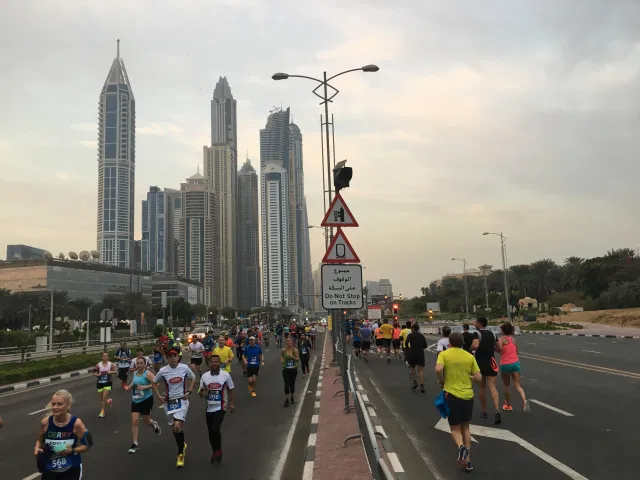
The first turn around near the 5k point.
I have been running long enough now to be able to accurately estimate my speed and adjust accordingly without looking at my Garmin (although I wear it), a feat facilitated by the fact that there were kilometer markers on the course, but no time clocks. So while I knew I was running faster than a 4:30 pace (10:20 per mile), I also expected to naturally slow some as the race wore on. Early-race excitement is a trap for inexperienced marathoners – those that think they feel good at 10k or the half and continue to push, only to have the wheels fall off at 18 or 20 because they’d been running too fast the whole time.

The light played tricks during the sun’s first appearance above the horizon. It would disappear behind cloud-cover for nearly another hour, before appearing for good, high in the sky, raising the temperatures to around 75 degrees Fahrenheit (23 degrees C)
I knew this “excited” feeling well, and told myself, not for the last time, to slow down.

Runners pass by one of the city’s architectural landmarks, the Burj al-Arab, the fourth tallest hotel in the world.
I looked at my watch for the first time at the 21k split, the half-way point, and did some quick math. I had been running faster than intended and was on PR pace, but barely. To actually finish with a record, I couldn’t slow down at all for the next 13.1 miles, an incredibly difficult task in the marathon. I was not optimistic, nor did I particularly want to turn this “fun run” into a race.

One of many mosques passed along the route, most with groups of men or women in traditional dress politely clapping for marathoners outside. For such a public course, there was little crowd support, and much of it from foreigners cheering on family members. In the background, the downtown Dubai cityscape, including the world’s tallest building, the Burj Khalifa, immediately to the right, standing at 2,722 feet (829 meters).
Rather, I continued to run at a pace that “felt good,” telling myself that I would check again at 32k, the 20-mile marker. In the meantime, I began picking out and picking off runners – finding someone in the distance who looked as though they were running slower than me, and then passing them, a mind game many runners play to entertain themselves during races.
At 32k, the place where many marathoners will tell you the race actually begins, I checked my Garmin again. My legs hurt. I was tired, having been in Dubai less than 48-hours and my body still believing itself back in Seattle where it was approaching 10:00pm, well passed my bedtime. If I sped up, not an unreasonable amount this late in the race, but enough, I could set a personal record. On the 7th race day, I thought in my head, triumphantly, I set a marathon PR. I sped up.
After the race, Bekele said of his DNF (Did Not Finish, an official race designation), “I like to think of many scenarios, but [falling at the start] was definitely not one of them! See you in London in April!” Or, in layman’s parlance, “It is my job to come out here and win races. It’s not smart to continue to push, risking further injury, when there is no longer a clear up-side. I have a bigger agenda.”
At 37k, mile 23, I abandoned my short-lived PR quest. I’d not sped up enough over the preceding 3 miles, and now needed to run my fastest 3 miles of the day to finish with a record. Still not completely out of reach, but certainly not in alignment with my bigger agenda – doing well at Black Canyon next month.
I finished Dubai in 4:18:31, slower than my PR BY 4 minutes and 52 seconds, 1:37 behind my Disney time and my third-fastest marathon ever. Well ahead of “plan.”

Race #7 finished, and in front of Kenenisa Bekele.
I see a tired runner in this photo; missing the spark and some of the post-race high. But I also see a runner who is fit to race another day which, with 33 races left in 2017, is the bigger agenda.
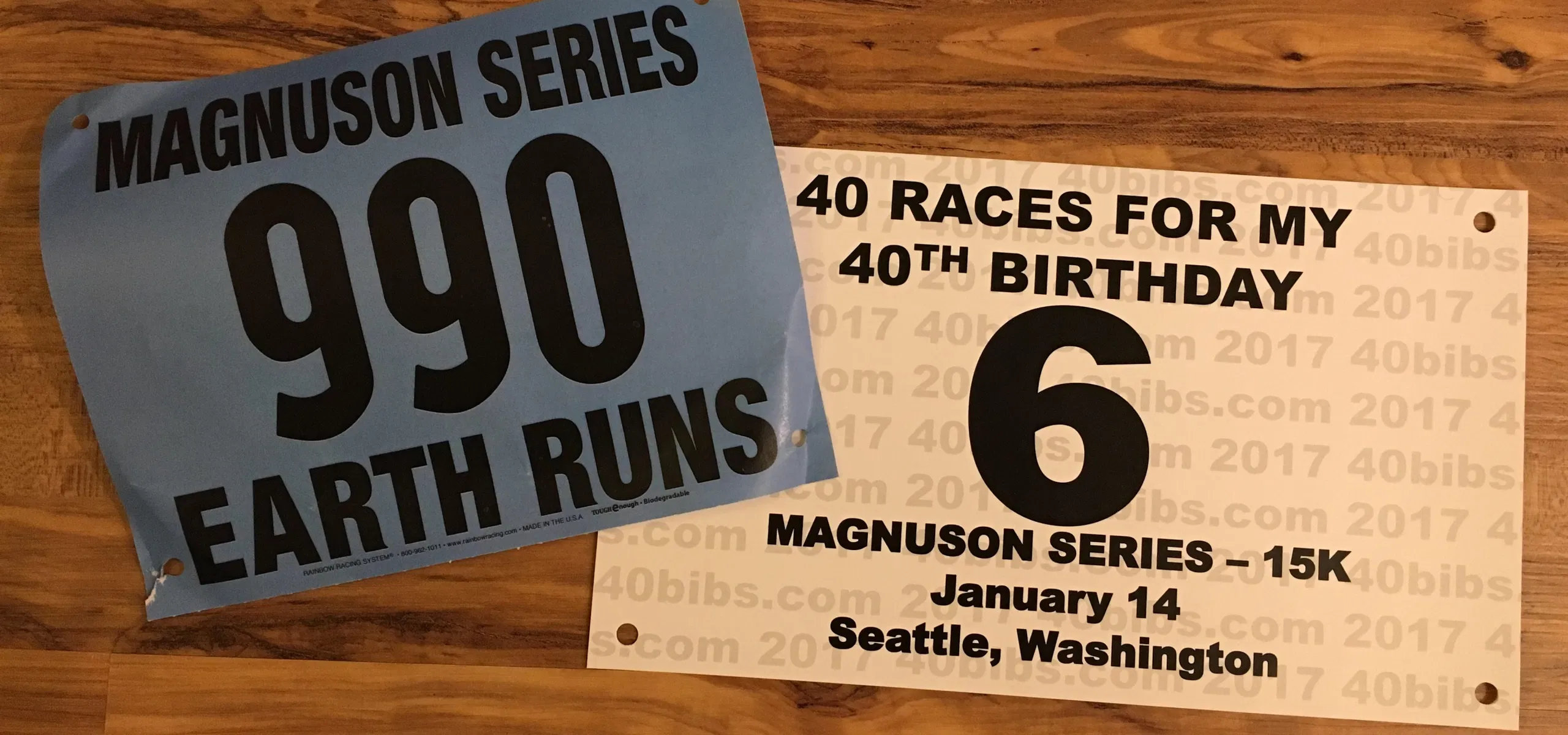
Damn, I thought, as he flew passed me on the right during one of the trail’s brief straightaways. What is it, like four and a half miles? I looked down at my Garmin: 4.68. I got lapped.
I’ve run the race series at Magnuson Park in Seattle several times. A 3.1 mile (5k) loop course, runners can sign up for the 5k, 10k or 15k distance. I have a course PR from last March — a personal record in the 15k against which I can measure every run there. It’s a way, objectively, to tracks my progress or how I’m feeling on any given day, whether or not I want to.

Just one mile into my commute to race start, the day was promising to be a beautiful one.
Saturday’s race was meant to be one part of a 15-mile training run, which I fulfilled by run-walking the six miles from my house to the race start. I am into the final four weeks of training for the Black Canyon 100k on February 18, one of two “big” races I have planned for the first half of 2017. Just six days off of a near-PR at the Walt Disney World Marathon, the fourth in four consecutive days of racing, my legs were fatigued. But running on tired legs is a key component of ultra training so, all things considered, I was fine with taking the 15k at Magnuson slow and easy. (Check out my live, start-line broadcast).
Until I got lapped by the eventual men’s winner at just 4.68 miles. And the second place finisher just shy of 6 miles. I’ve run this race four times previously and never been lapped by anyone, never mind two people in the same race.
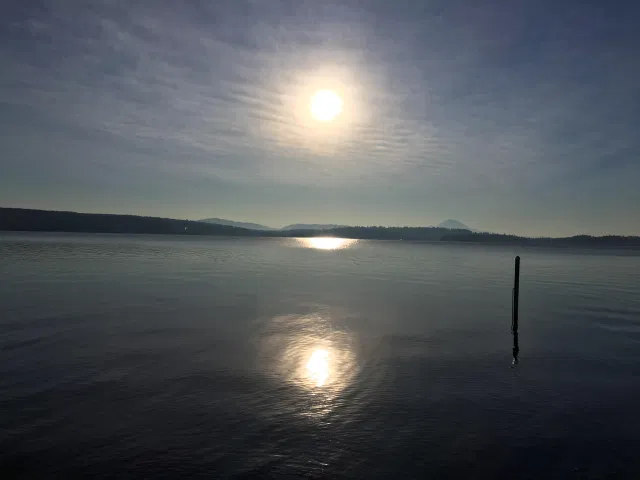
On a clear day like Saturday, you can see Mt. Rainier across Lake Washington from the start/finish line at Magnuson Park.
I finished the race more than 9 minutes slower than my personal record, approximately 1 minute per mile. I faltered when a very nice man and his daughter, rested after their own 15k finish, asked me how I did. Upon realizing far too many words were coming out of my mouth to answer such a simple question, I defaulted to, “but it’s a beautiful day. How was your run?” They had a great race, they said. “Awesome,” I responded, and I meant it. I accomplished exactly what I set out to accomplish. Getting lapped didn’t change my race, it only made it more memorable.
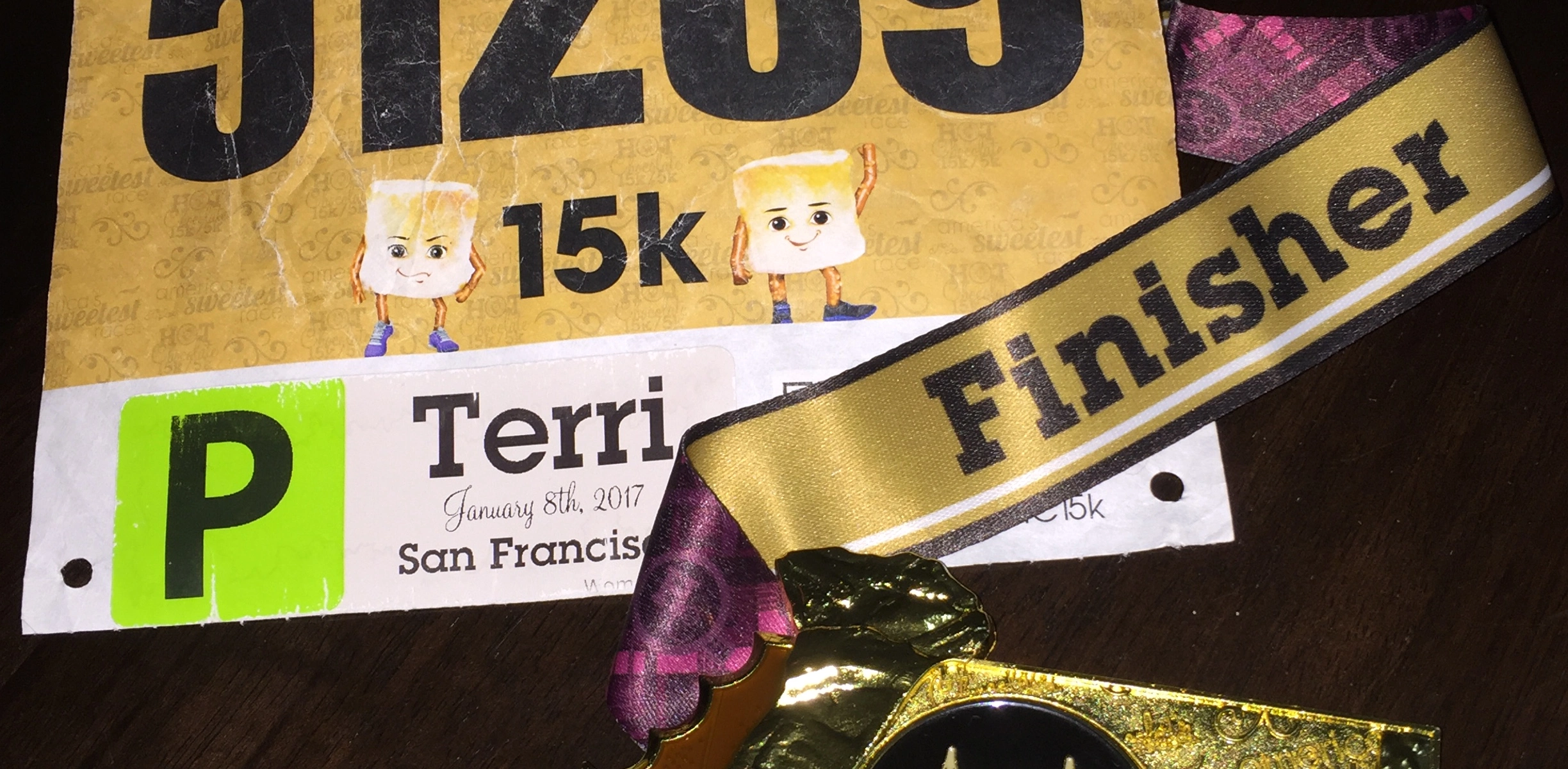
A huge part of my 40 bibs challenge is supporting 40 other runners in their finish line quests and, much to my delight, several of them have agreed to let me share their journey here.
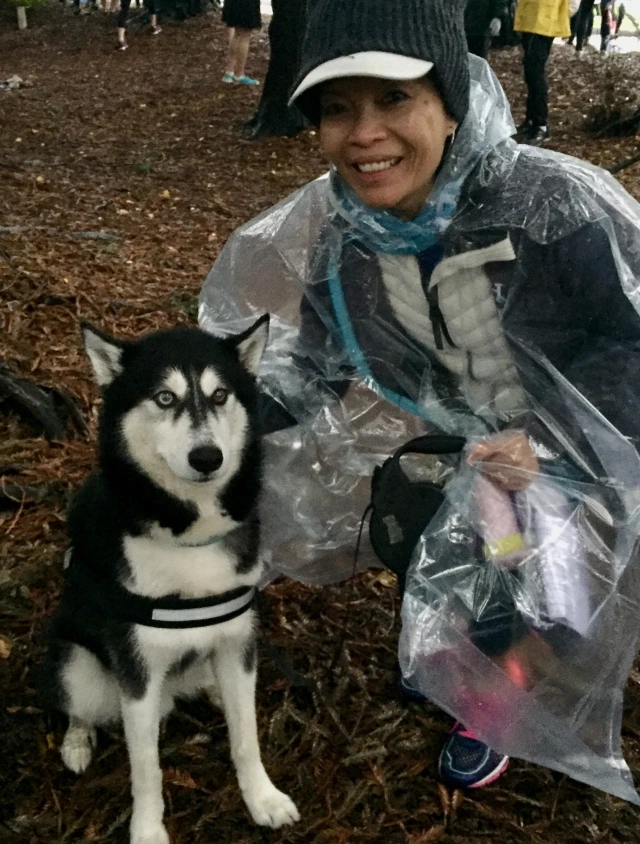
Here is Terri and a friend, ready to go on the very wet race course.
Meet Terri! Just one day after my 4th race, the Walt Disney World Half Marathon, was cancelled due to severe thunder storms, Terri braved similar weather to run the Hot Chocolate 15k in San Francisco. Here are a few more of her great photos from the race!
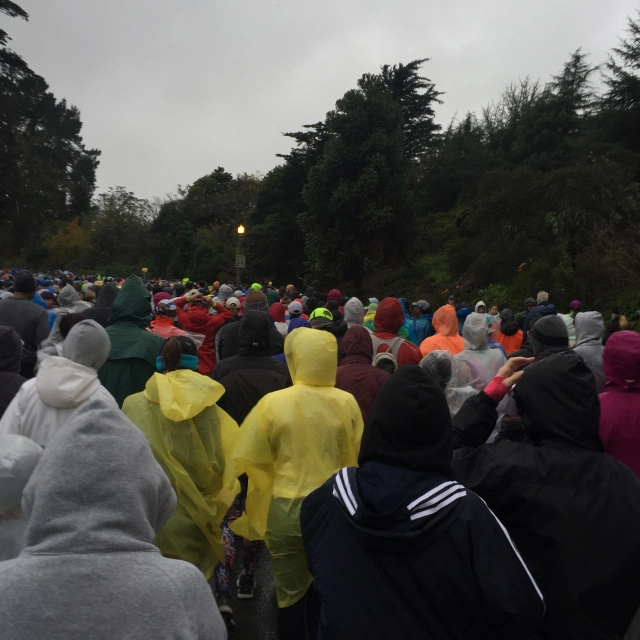
Runners ready to traverse the course inside of Golden Gate Park in San Francisco.
Congratulations to Terri, and all the Hot Chocolate runners!
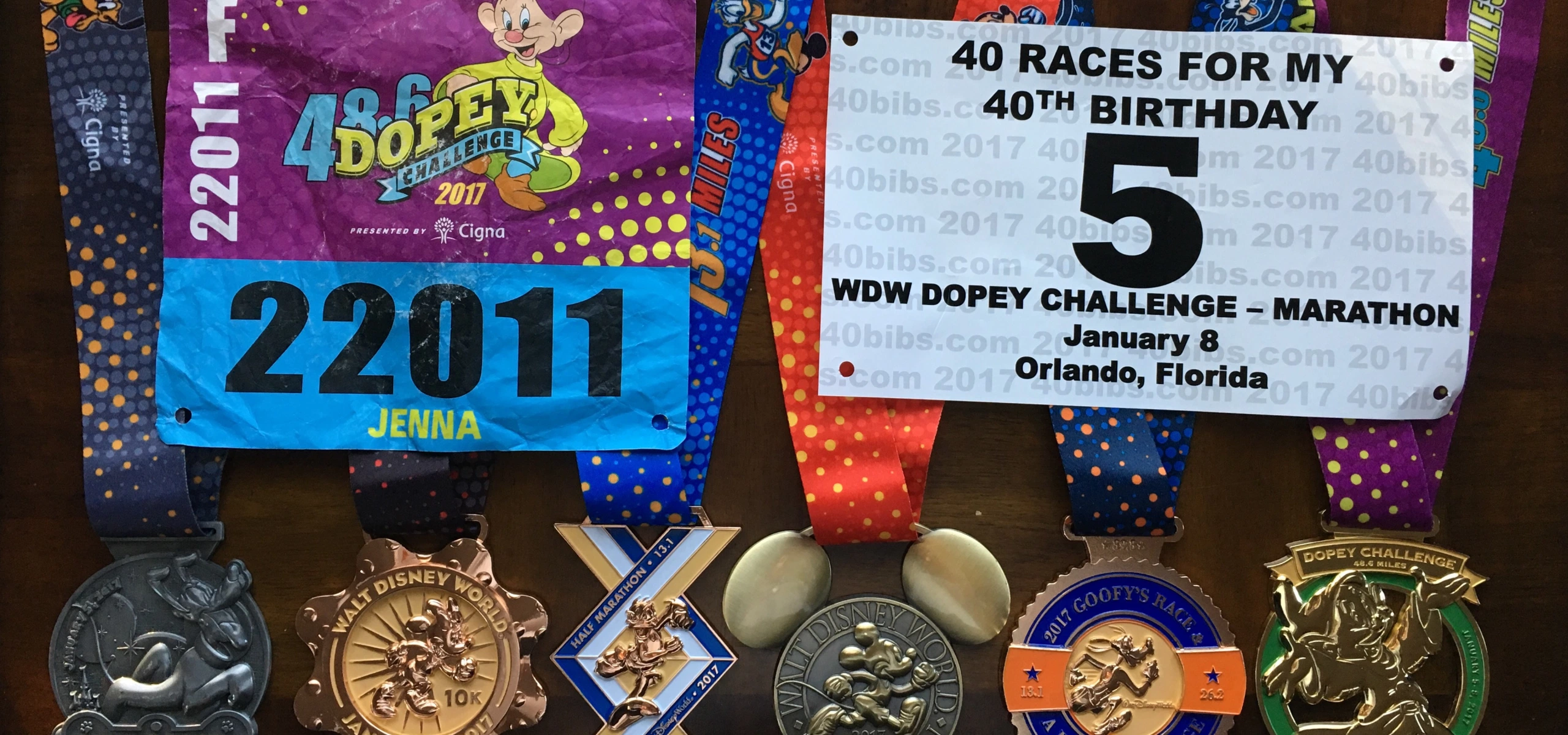
The marathon is fickle. Some days, it’s in love with you. It caresses you mile after mile; whispering sweetly in your ear and sending shivers of pleasure down your spine. These are the days that linger in your mind on the other days, when the marathon is abusive. On the days when it kicks you squarely in your soul, crushes your confidence, and draws tears. And prepare as you might to ensure it will treat you in the former manner and not the latter, you can never guarantee it. The marathon will always behave as it wants.
I went out cautiously, having just shed the cheap teal, velour blanket I’d held wrapped around my my waist since departing the warmth of my car for my start corral, thirty minutes prior. At below 40 degrees, the air threatened to seize my already fragile legs. This was my fourth race in four days, sixth race in nine days, and the culmination of a 67-mile training week. The marathon’s patience with me already seemed thin.
I bided my time through 10k, maintaining a comfortable pace, even stopping to use the bathroom. See, I showed it, this race doesn’t matter to me. I’m not trying to do anything here.
So too through the half, when on other days I would have begun imposing my will on it. I didn’t trust that the marathon wasn’t just lulling me into a false sense of security. It’s dominance was already becoming evident around me, as those who were compliant gave in quickly to its ire and began walking, while others grimaced in their refusal to succumb, now with 8 miles remaining.
At 20 miles, I remained docile, my October Chicago Marathon still fresh in my mind. I’d lost minutes in miles 20 through 23 when the marathon decided, with just a 10k left to go, that it would let me break my own personal record, but not by as much as I’d wanted to.
It was 24 miles by the time I trusted it enough to push. What can you possibly do to me in 2.2 miles? I asked it, rhetorically.
The marathon didn’t answer.
I crossed the finish line just 3 minutes and 15 seconds off my personal record, a “second-best” time by four minutes.
Could I have found the 3 minutes and 15 seconds over 26.2 miles to give me a personal record? I don’t know. I don’t think the marathon loved me yesterday, I think it just wanted to pay me a complement.
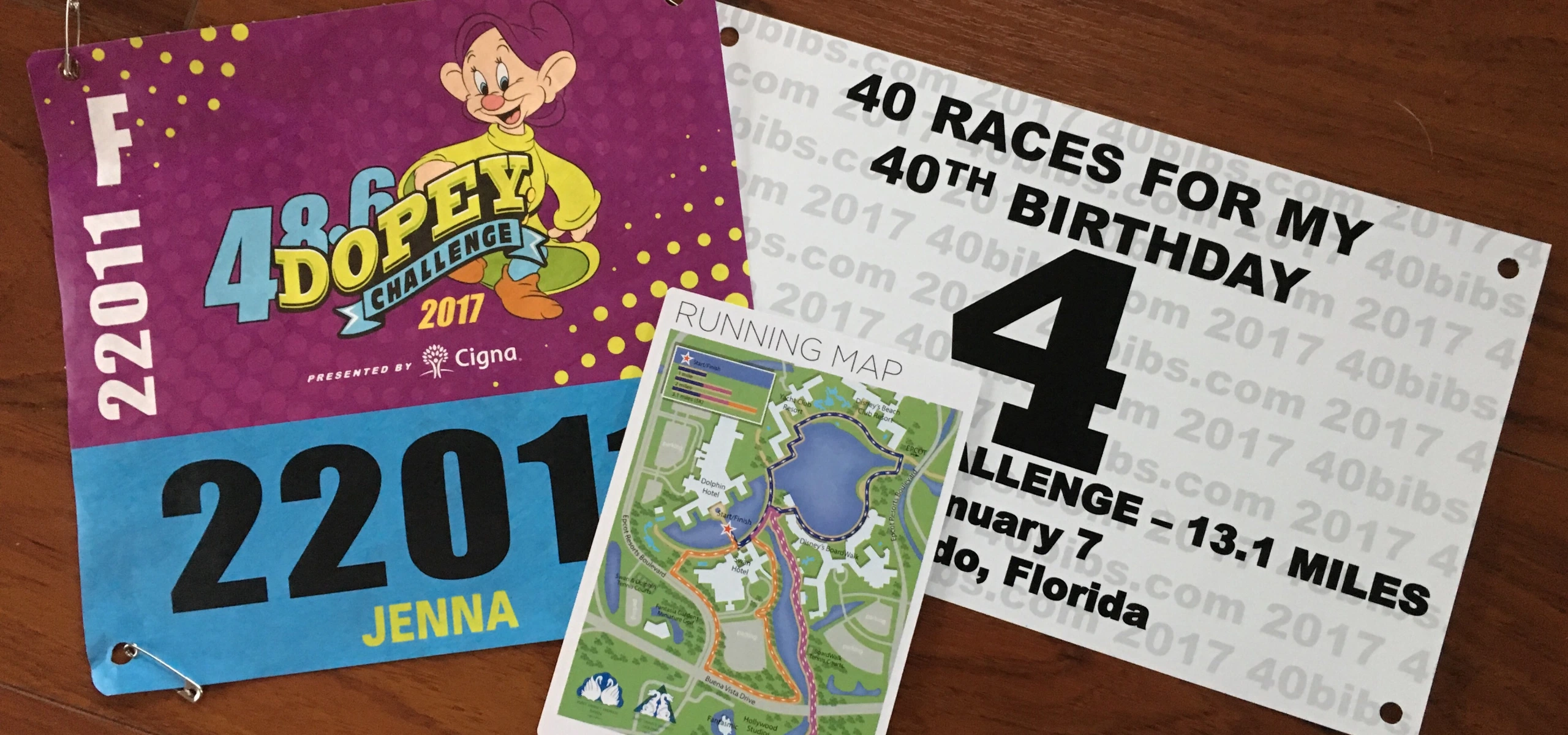
By 10:00pm Friday night, the Walt Disney World Half Marathon hashtag was trending on Twitter, right behind a Fort Lauderdale airport shooting that claimed five lives.
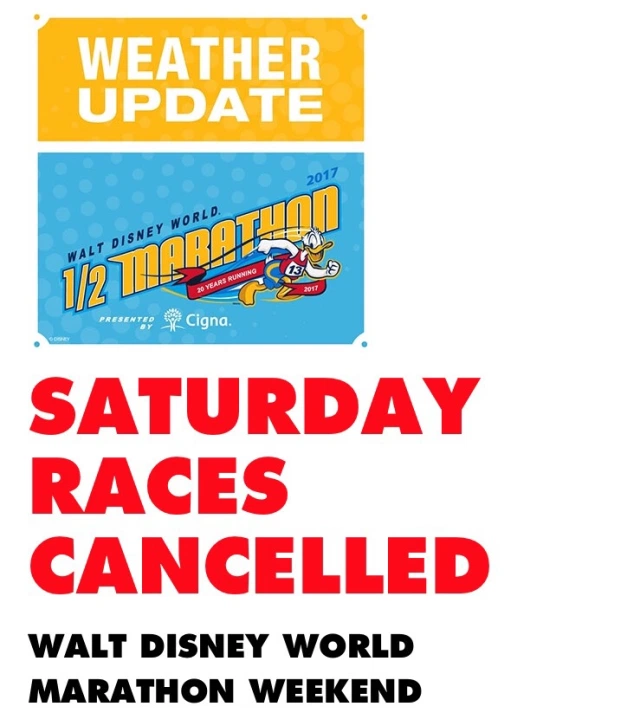
It took a single social media post to dash the hopes of more than 20,000 Walt Disney World runners on Friday night.
“In an abundance of caution,” the announcement read, “the Walt Disney World Resort has canceled all running events on Saturday, January 7, 2017 due to weather conditions. This includes the Walt Disney World Half Marathon and the runDisney kids races.”
For more than 20,000 registered half marathon runners, this meant months of training and sacrifice for not. For nearly 10,000 registered for Goofy’s Race and a Half (half marathon and full marathon) and the Dopey Challenge (5k, 10k, half and full), it meant a challenge unfulfilled. While nearly all understood safety being paramount (especially once most of us were awoken by cracks of thunder around the time we otherwise would have been on our way to the start line), it was still hard to accept. Disney offered up our medals, but who wants a medal for a race you didn’t run?
Running is perhaps the simplest form of exercise. Despite an obsession with the latest gear and gadgets, the truth is you only need your sneakers. And if you only need your sneakers to run, how much more, really, do you need to run a race?
The answer, it turned out, was a handful of people who felt the same way. (Check out my live, mid-race broadcast!)
Once the last of the storms cleared around 8:30am, three hours after the official race would have started, bibbed and costumed runners began dotting the paths and walkways snaking through the Disney resort areas.
By 10am there were hundreds, cheered on by spectators and non-running visitors.

Located a the convergence of two running paths, these women were a source of encouragement (and cowbell!) for hours.
“Aid stations” and cheer zones appeared.

One of Friday’s 10k runners and her husband offering water and granola bars, one of several pop-up “aid stations.”
And, one by one, two by two and in groups, runners completed their 13.1 miles.

Team Fox, Michael J. Fox’s foundation for Parkinson’s research, recreated their official race cheer zone on the unofficial half course.
I am honored to be among that group, having boldly run in a T-shirt announcing, “WE RUN THE WORLD.” Hyperbole, perhaps, but for a brief time today, we runners did run Disney– on our own terms.
“So,” I’ve been asked. “Does this count as one of your 40 bibs?” To the extent that a race has a definite starting and ending point, and some kind of official clock so we can all track exactly how long it took to run the prescribed distance, no, I don’t think this counts. But to the extent that the purpose of my 40bibs journey is to, as my friend Julie Hinson would say, “grow and become;” to the extent that the journey is about seeing what I’m made of; and to the extent that it’s about supporting other racers, the answer is, yes. And I cannot think of a race that would count for more.
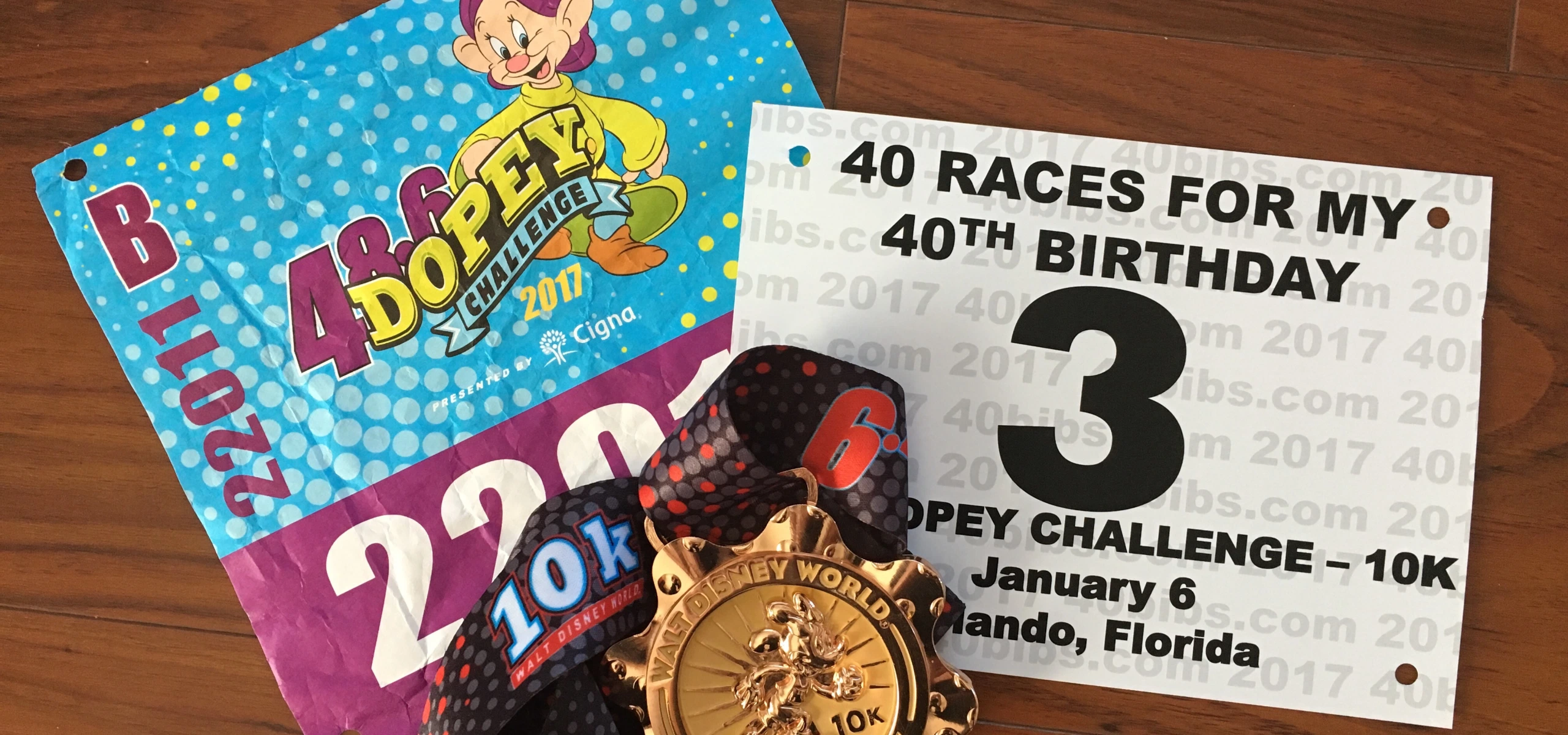
There were spectators on the course today. On the Boardwalk specifically, a looped area made to look like an old fashioned, summertime coastal Atlantic City. Spectators.
Non-runners assume spectators line every course, because that’s what they’ve seen on television during the Olympics or the New York City Marathon (if someone has forced them to watch such tedium). But the truth is, the sidewalks of most courses are empty.
So to have spectators on the course of a 5:30am race in 50 degree weather is something special.
It’s bad enough that we racers drag ourselves out of bed before sun-up in the heat, the cold, the wind and the rain; we’ve paid to subject ourselves to these rituals. The friends and family members that tag along, not so much. They wait, sometimes for hours, for a glimpse of a loved one. A brief wave or, if their runners is particularly laissez faire, a hug and a photo. The sacrifice/benefit scale is decidedly tipped in the runner’s favor.
On behalf of the runners, espcically those of us who run knowing there is no one looking for us on the course or the finish line – I thank you. I thank you for your cheers, your high fives, and the occasional Great Job Stranger! sign. I am grateful for the sacrifices you are making to give me a few seconds of encouragement in what can be a very lonely sport if we let it.
I look forward to seeing you again tomorrow.
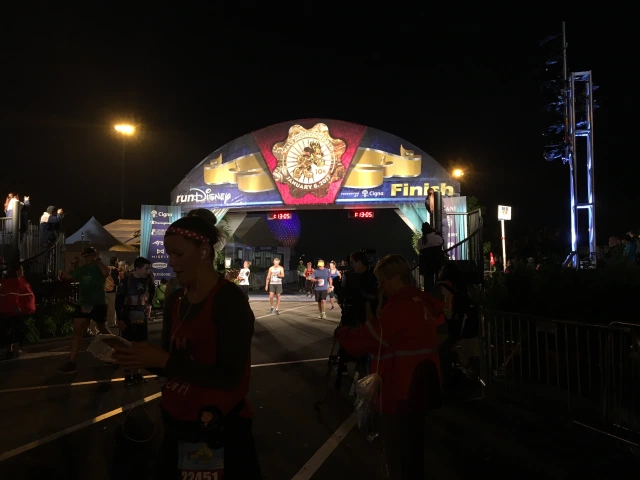
In the blackness, hundreds of finish line spectators on painfully frigid metal bleacher seating. The sun won’t rise for another 40 minutes. Check out my live, start-line broadcast here.

